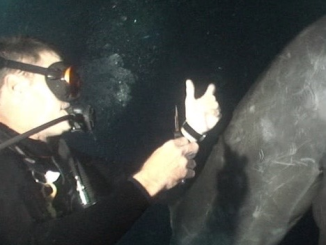
A heartbreaking story comes from Southern California, where a tiny gray-and-white dog was spotted lying in a school parking lot next to the school’s shrubs.
She was waiting for her family who abandoned her to come back, refusing to leave that very spot, and hiding from anyone who wanted to help her.
Weeks went by, but no one claimed this dog, nor did anyone come back for her. She was all alone in this world, still not realizing that her previous owners are no longer her family…
Little Doggo Girl Was Inclined To Wait For Her Hoomans To Come Back

Despite the fact that no one came back for her for fifteen days, this little dog girl refused to budge from the parking lot shrubs. She was inclined to wait for as much as she needed to for her family to come back.

Many people tried to help her, sharing her photos online in hopes of finding her family, but no one ever claimed her. And, even when someone would try to approach her directly, she’d always hide, until one day, a woman named Suzette Hall came by.
Suzette Made Sure The Dog Got A Fresh Start

Source: @logans_legacy29
Suzette is the founder of the Logan’s Legacy animal rescue in Irvine, California. When she came across the dog’s story, she had no doubts about helping her. Suzette drove herself to the school and searched for this doggo.
“For 15 days, there she was in the morning, afternoon, and then the night. Neighbors tried to help her, but she was too scared. I know she believed if she stayed there, they would come back for her. Loyal little girl,” she wrote.
As she was extremely fearful and shy, Suzette decided to set a humane trap with a hot dog in it. Even though this pup wasn’t exactly starved as she was fed by kibble, Suzette chose the right food to lure her in!
When she finally got her, the doggo girl was frightened and panicky, but she eventually calmed down and fell asleep in Suzette’s car. She decided to name the dog “Scarlet”.

 Source: The Dodo Even though she’s now happy in a new foster home, Scarlet’s still seeking for her furever family. This lovable dog is easy-going, affectionate, and she pretty much gets along with everyone she meets.Adapting to a new family is definitely not going to be a problem for Scarlet, as she’s naturally a sweet doggo with great social skills!Suzette has one condition for the future family who decides to adopt Scarlet, though – it has to be someone who will never, ever leave her again!Scarlet being abandoned once again under some tree is simply inadmissible, and Suzette hopes she will finally learn what true love looks like. We wish for little Scarlet to find her pawfect home as soon as possible!
Source: The Dodo Even though she’s now happy in a new foster home, Scarlet’s still seeking for her furever family. This lovable dog is easy-going, affectionate, and she pretty much gets along with everyone she meets.Adapting to a new family is definitely not going to be a problem for Scarlet, as she’s naturally a sweet doggo with great social skills!Suzette has one condition for the future family who decides to adopt Scarlet, though – it has to be someone who will never, ever leave her again!Scarlet being abandoned once again under some tree is simply inadmissible, and Suzette hopes she will finally learn what true love looks like. We wish for little Scarlet to find her pawfect home as soon as possible!Which of the five children just went out and then went back to bed
Have you ever come across a puzzle that seemed simple at first glance but had you scratching your head as you tried to solve it? Today’s puzzle is one of those engaging brain teasers. Take a closer look at the image of the five children peacefully sleeping in their beds. The challenge is to figure out: Which child just went out and climbed back into bed?

The Allure of Brain Teasers: Why We Love a Good Challenge
Puzzles like this one are not just fun—they challenge our minds to think outside the box. They test our ability to notice details, connect the dots, and use reasoning to arrive at an answer. But they also remind us of how easily we can overlook critical clues when we’re not paying close attention.
So, before you scroll down for the explanation, take a moment to look at the image carefully. Study every detail. Can you spot anything unusual about one of the children?
Common Mistakes: Why Many Get It Wrong
When solving puzzles like this, it’s easy to miss the subtle hints that lead to the correct answer. Here are some common pitfalls people face:
- Assuming Too Much: Many people assume that because the children are in bed, there’s nothing unusual to notice. But a good puzzle hides its clues in plain sight.
- Rushing Through the Details: In puzzles, tiny inconsistencies often hold the key to the solution. Rushing means you’re likely to miss these.
- Overcomplicating the Answer: Sometimes, we think the solution must be complex and overlook the simplest explanation.
For this puzzle, the key lies in observing the children closely and noticing what sets one of them apart.
Step-by-Step Guide to Solving the Puzzle
Let’s break it down step by step and uncover the answer.
Step 1: Observe the Overall Scene
Take a good look at all five children sleeping in their beds. Notice their postures, their blankets, and anything that seems out of the ordinary.
- All five children appear to be peacefully sleeping.
- The room is dimly lit, with a calming green wall and neatly arranged beds.
Step 2: Look for Something Unusual
The trick to solving this puzzle is to spot the small details that don’t fit. Scan each child one by one. Do you notice anything peculiar about their clothing, the way they’re positioned, or the items around them?
- Four of the children are fully under their blankets, with no visible irregularities.
- One child, however, stands out. The girl on the left side of the image is still wearing shoes under her blanket.
Step 3: Connect the Clue to the Question
The presence of shoes is the defining clue here. If the girl still has her shoes on, it means she didn’t have time to take them off before getting back into bed. This suggests she must have just come back from somewhere.
Step 4: Rule Out the Other Children
Now that you’ve identified the key detail, you can confidently rule out the other four children. None of them have any unusual characteristics, like shoes or signs of movement, to suggest they recently left their beds.
The Final Answer: The Girl on the Left

The correct answer to the puzzle is the girl on the left. Her shoes give her away—they’re the subtle but crucial clue that confirms she was the one who went out and climbed back into bed.
Why Details Matter in Puzzles (and in Life)
This puzzle serves as a great reminder of how often we miss the small details in our day-to-day lives. It’s easy to get caught up in the bigger picture and overlook the little things that can change the outcome entirely. Whether you’re solving puzzles or navigating real-life challenges, paying attention to details can make all the difference.
Share Your Thoughts and Keep Challenging Yourself
What did you think of this puzzle? Did you manage to figure out the answer, or did the girl’s shoes catch you by surprise? Share your thoughts in the comments and let us know how long it took you to spot the clue.
If you enjoyed this puzzle, why not challenge your friends and family to solve it too? And don’t stop here—there are countless other brain teasers and logic puzzles out there waiting to sharpen your skills and stretch your mind.
Conclusion: Keep Your Mind Sharp with Puzzles
Puzzles like this one are not just a source of entertainment—they’re a workout for your brain. By tackling challenges like these, you’re honing your observational skills, improving your problem-solving abilities, and having fun all at the same time.
So, next time you encounter a tricky brain teaser, take a deep breath, slow down, and look for the hidden clues. And remember: the answer is often right in front of you, just waiting to be discovered!



Leave a Reply